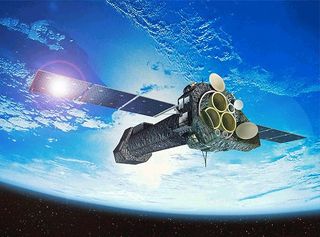Europe's XMM-Newton Telescope Celebrates 20 Years of X-Ray Astronomy
Happy birthday, XMM-Newton!
A European Space Agency telescope celebrated 20 years of exploring the secrets of the X-ray universe this week.
The XMM-Newton telescope, which launched on Dec. 10, 1999, has made contributions in various fields of science and astronomy, and has observed objects ranging from galaxy clusters to star flares. But in a press release celebrating the anniversary, scientists zeroed in on the observatory's black hole discoveries.
Black holes are areas in space that are so dense that no other object can escape their pull after passing beyond a point of no return known as the "event horizon." Even light can't escape, which means the black holes can't be seen. But when black holes munch on nearby gas, dust or objects, they produce a distinctive glow that can be mapped out in X-rays.
Video: XMM-Newton Space Observatory at 20 - Highlights
Related: Our Galaxy's Heart Glows in Psychedelic X-Ray Light

Although XMM-Newton can't see black holes directly — in fact, the first-ever image of a black hole was just produced this year using data from the Event Horizon Telescope, a collaboration of observatories from around the world (that does not include XMM-Newton).
What XMM-Newton is good at is seeing X-rays produced by iron molecules. These molecules are heated to high temperatures and ionized, or stripped of their electrons, on their death plunge toward the black hole.
The observatory has made several discoveries in the field of supermassive black holes, which are thousands of times the mass of the sun and which tend to be embedded in galaxies. XMM-Newton made a key find using iron molecules in a supermassive black hole in 2013.
Get the Space.com Newsletter
Breaking space news, the latest updates on rocket launches, skywatching events and more!
"The X-rays given out from the iron contain information about the geometry and dynamics of the black hole," ESA said in a statement. "XMM-Newton was used to measure such emission in order to study the rotation rate of the supermassive black hole at the center of the spiral galaxy NGC 1365."
XMM-Newton also spotted flashes from a black hole embedded in the galaxy GSN 069, emanating about once every nine hours. "These eruptions are thought to be coming from the matter caught in the black hole’s gravitational grip, or from a less massive black hole circling the more massive one," ESA said in the statement.
XMM-Newton is still working well, and the observatory will focus on supermassive black holes and the galaxies in which they are hosted in the coming years.
- The Stuff Falling into This Black Hole Is Moving at Almost 56,000 Miles a Second!
- NICER Telescope Spots Brightest X-Ray Burst Ever Observed
- Behold! This Stunning Light Art Is Actually a Sky Filled with X-Rays
Follow Elizabeth Howell on Twitter @howellspace. Follow us on Twitter @Spacedotcom and on Facebook.

Join our Space Forums to keep talking space on the latest missions, night sky and more! And if you have a news tip, correction or comment, let us know at: community@space.com.

Elizabeth Howell (she/her), Ph.D., is a staff writer in the spaceflight channel since 2022 covering diversity, education and gaming as well. She was contributing writer for Space.com for 10 years before joining full-time. Elizabeth's reporting includes multiple exclusives with the White House and Office of the Vice-President of the United States, an exclusive conversation with aspiring space tourist (and NSYNC bassist) Lance Bass, speaking several times with the International Space Station, witnessing five human spaceflight launches on two continents, flying parabolic, working inside a spacesuit, and participating in a simulated Mars mission. Her latest book, "Why Am I Taller?", is co-written with astronaut Dave Williams. Elizabeth holds a Ph.D. and M.Sc. in Space Studies from the University of North Dakota, a Bachelor of Journalism from Canada's Carleton University and a Bachelor of History from Canada's Athabasca University. Elizabeth is also a post-secondary instructor in communications and science at several institutions since 2015; her experience includes developing and teaching an astronomy course at Canada's Algonquin College (with Indigenous content as well) to more than 1,000 students since 2020. Elizabeth first got interested in space after watching the movie Apollo 13 in 1996, and still wants to be an astronaut someday. Mastodon: https://qoto.org/@howellspace
